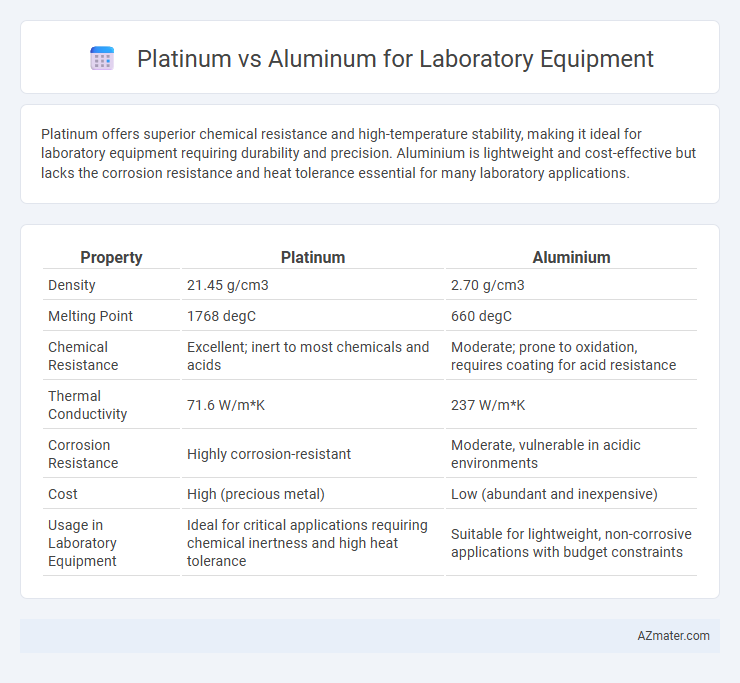Platinum offers superior chemical resistance and high-temperature stability, making it ideal for laboratory equipment requiring durability and precision. Aluminium is lightweight and cost-effective but lacks the corrosion resistance and heat tolerance essential for many laboratory applications.
Table of Comparison
| Property | Platinum | Aluminium |
|---|---|---|
| Density | 21.45 g/cm3 | 2.70 g/cm3 |
| Melting Point | 1768 degC | 660 degC |
| Chemical Resistance | Excellent; inert to most chemicals and acids | Moderate; prone to oxidation, requires coating for acid resistance |
| Thermal Conductivity | 71.6 W/m*K | 237 W/m*K |
| Corrosion Resistance | Highly corrosion-resistant | Moderate, vulnerable in acidic environments |
| Cost | High (precious metal) | Low (abundant and inexpensive) |
| Usage in Laboratory Equipment | Ideal for critical applications requiring chemical inertness and high heat tolerance | Suitable for lightweight, non-corrosive applications with budget constraints |
Introduction to Platinum and Aluminium in Laboratory Equipment
Platinum is a highly durable and chemically inert metal commonly used in laboratory equipment for its excellent resistance to corrosion and high temperatures, making it ideal for crucibles, electrodes, and catalyst supports. Aluminium, by contrast, offers lightweight and cost-effective properties with good thermal conductivity, widely utilized in lab accessories such as sample holders, trays, and certain reaction vessels. The choice between platinum and aluminium depends on the specific laboratory application requirements, including chemical resistance, thermal stability, and budget constraints.
Physical and Chemical Properties Comparison
Platinum exhibits exceptional resistance to corrosion and oxidation, maintaining stability at high temperatures up to 1768degC, making it ideal for laboratory equipment requiring durability under extreme conditions. Aluminium offers excellent thermal conductivity and lightweight characteristics but melts at a much lower temperature of 660degC and oxidizes more readily, limiting its use in high-temperature or highly reactive chemical environments. The chemical inertness of platinum to most acids and bases ensures minimal contamination in sensitive experiments, whereas aluminium's reactivity requires protective coatings to enhance resistance.
Durability and Longevity
Platinum offers exceptional durability and resistance to corrosion, making it ideal for laboratory equipment subjected to extreme heat and chemical exposure. Aluminium, while lightweight and cost-effective, is prone to oxidation and wear over time, reducing its lifespan in harsh laboratory environments. The superior longevity of platinum ensures consistent performance and minimal maintenance, justifying its higher cost in precision scientific applications.
Resistance to Corrosion and Contamination
Platinum laboratory equipment exhibits exceptional resistance to corrosion, maintaining integrity in aggressive chemical environments such as strong acids and bases, which ensures minimal contamination risk during sensitive experiments. Aluminium, while lightweight and affordable, is prone to oxidation and can degrade when exposed to certain chemicals, potentially introducing contaminants into experimental samples. The superior chemical inertness of platinum makes it the preferred choice for applications demanding high purity and minimal contamination.
Thermal Conductivity and Stability
Platinum offers superior thermal stability and resistance to corrosion, making it ideal for high-temperature laboratory applications where precise thermal control is critical. Aluminium provides excellent thermal conductivity, facilitating rapid heat transfer, but it lacks the chemical and thermal stability of platinum under extreme conditions. Choosing between platinum and aluminium depends on the specific laboratory requirements for thermal performance and material durability.
Cost-Effectiveness and Availability
Platinum offers exceptional chemical resistance and durability for laboratory equipment but comes with a significantly higher cost and limited availability compared to aluminum. Aluminum provides a cost-effective alternative with good corrosion resistance and lightweight properties, making it widely accessible for general laboratory use. Balancing budget constraints and performance needs often leads to aluminum being the preferred choice for standard applications, while platinum is reserved for specialized tasks requiring superior chemical inertness.
Application Suitability in Different Laboratory Processes
Platinum offers exceptional resistance to corrosion and high temperatures, making it ideal for crucibles, electrodes, and catalysts in high-temperature and chemically aggressive laboratory processes. Aluminum is lightweight, cost-effective, and excellent for general lab equipment like trays, tanks, and supports but lacks the durability required for high-temperature or highly reactive environments. Choosing between platinum and aluminum depends on the specific laboratory application, with platinum preferred for precision and durability in extreme conditions, while aluminum suits routine, less demanding tasks.
Maintenance Requirements and Ease of Cleaning
Platinum laboratory equipment requires minimal maintenance due to its exceptional corrosion resistance and chemical inertness, making it ideal for use in harsh chemical environments. Aluminium, while lightweight and cost-effective, demands more frequent cleaning and careful handling to prevent oxidation and surface degradation. The ease of cleaning platinum surfaces significantly reduces contamination risks, enhancing lab safety and ensuring accurate experimental results.
Environmental Impact and Sustainability
Platinum offers exceptional corrosion resistance and longevity in laboratory equipment, reducing the need for frequent replacements and minimizing environmental waste. Aluminium, while lighter and more energy-efficient to produce, often requires protective coatings that may introduce environmental hazards during disposal. Considering sustainability, platinum's durability supports long-term use, whereas aluminium's recyclability helps lower its overall environmental footprint.
Conclusion: Choosing the Right Material for Laboratory Needs
Platinum offers superior corrosion resistance and catalytic properties, making it ideal for high-precision analytical instruments and chemical reactions requiring inertness. Aluminium provides lightweight and cost-effective solutions suitable for general laboratory equipment with moderate durability requirements. Selecting the appropriate material depends on balancing budget constraints with the need for chemical resistance and functional longevity in specific laboratory applications.

Infographic: Platinum vs Aluminium for Laboratory Equipment
 azmater.com
azmater.com